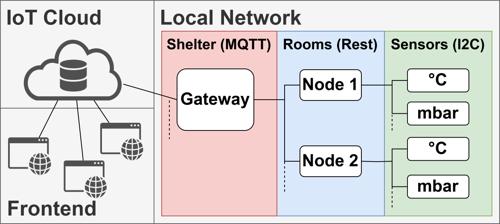Internet of Things for the Monitoring of Shelters and Protection Structures
- Degree programme: BSc in Elektrotechnik und Informationstechnologie
- Authors: Silvan Pfahrer, Kevin Dan Reber, Simon Stoll
- Thesis advisors: Prof. Dr. Andrea Ridolfi, Mauro Carcano
- Expert: Cédric Vuilleumier
- Year: 2023
Switzerland is one of the countries with the highest density of shelters and protection structures. It therefore faces unique maintenance challenges, which can be met by remote monitoring. Due to the unique structure of these buildings, conventional solutions fall short. Modularity, scalability, and reliable transmission through thick walls are crucial requirements. A wired PoE system meets these needs, ensuring both power supply and data transmission via a single connection.
Concept
Shelter maintenance relies on the measurement of parameters such as temperature, humidity, and pressure. Based on an earlier feasibility study, we developed a monitoring system that satisfies the requirements of modularity, scalability, reliability, and ease of installation. Emphasis was placed on the transition from prototype to final product.
Implementation
Compared to the prototype from the feasibility study, we've achieved better integration and divided the sensor nodes into two distinct parts. This avoids thermal interference between the main module and the sensors. For the main module, smaller components were used and a custom PCB was developed. This PCB accepts the microcontroller and power module as daughter boards and it also integrates Ethernet communication. The sensor module, which is housed separately, can easily mount different sensors.On the software side, a strong emphasis was placed on maintainability, stability, and security. The implementation involves multiple encryption protocols, with secure software updates, distributable over the network. A dedicated web frontend was developed to provide an interface for data visualization and analysis.
Results
Following a successful deployment in an actual shelter located in Interlaken, the system demonstrated significant benefits. This includes the ease of installation and reliability as well as no significant thermal interference. Moreover, the new system significantly enhanced the efficiency of remote monitoring and data collection frequency, which is crucial for optimal shelter maintenance.
Conclusion
We’ve successfully created a system for monitoring shelters and protection structures that is reliable, can be easily scaled and reconfigured, and is close to its final version. This system can be effectively managed even by those without great technical knowledge. Its versatile software and hardware components pave the way for seamless future upgrades or replacements as needed for various applications.
Outlook
A second mobile system via Bluetooth for selective, issue-specific tracking, such as local humidity problems could be implemented in the future. The currently used sensors are on individual breakout boards, which is advantageous for rapid iteration and prototyping. However, in a next generation, they could be integrated onto a single custom PCB.

